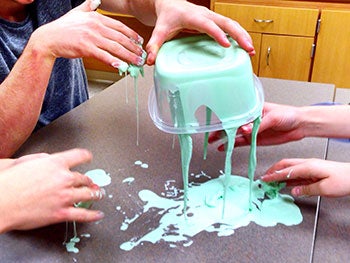The mystery of oobleck: insights on shear thickening
Posted in News Story
Research by Dr. John Royer (NIST), Prof. Daniel Blair (Georgetown), and Dr. Steven Hudson (NIST), recently published in Physical Review Letters, provides new insights on the mechanisms by which colloids change from being liquid-like to solid-like when stressed. This phenomenon, called shear thickening, is easily demonstrated with a corn-starch-and-water slurry (oobleck): normally, the material flows like a liquid, but in response to mechanical stress, it becomes solid-like. This type of behavior is important in industrial processes, where it can be a desired property in some cases or one to be avoided in others. Using a state-of-the-art rheometer, developed in the Blair lab, the team measured the stress response of colloids with different volume fractions of particles. Their results suggest that shear thickening is driven primarily by the formation of frictional contacts between the particles, with hydrodynamic lubrication forces playing a supporting role at lower concentrations.

For more information:
- NIST press release: A crack in the mystery of oobleck — friction thickens fluids
- Georgetown highlight: Research on ‘Oobleck’ Could Enhance Body Armor, Softer Robots
- Research article: Rheological Signature of Frictional Interactions in Shear Thickening Suspensions, John R. Royer, Daniel L. Blair, and Steven D. Hudson, Phys. Rev. Lett. 116, 188301 (2016)
- Blair lab website
- Georgetown’s Institute for Soft Matter Synthesis and Metrology
Photo: David Mulder via Flickr
